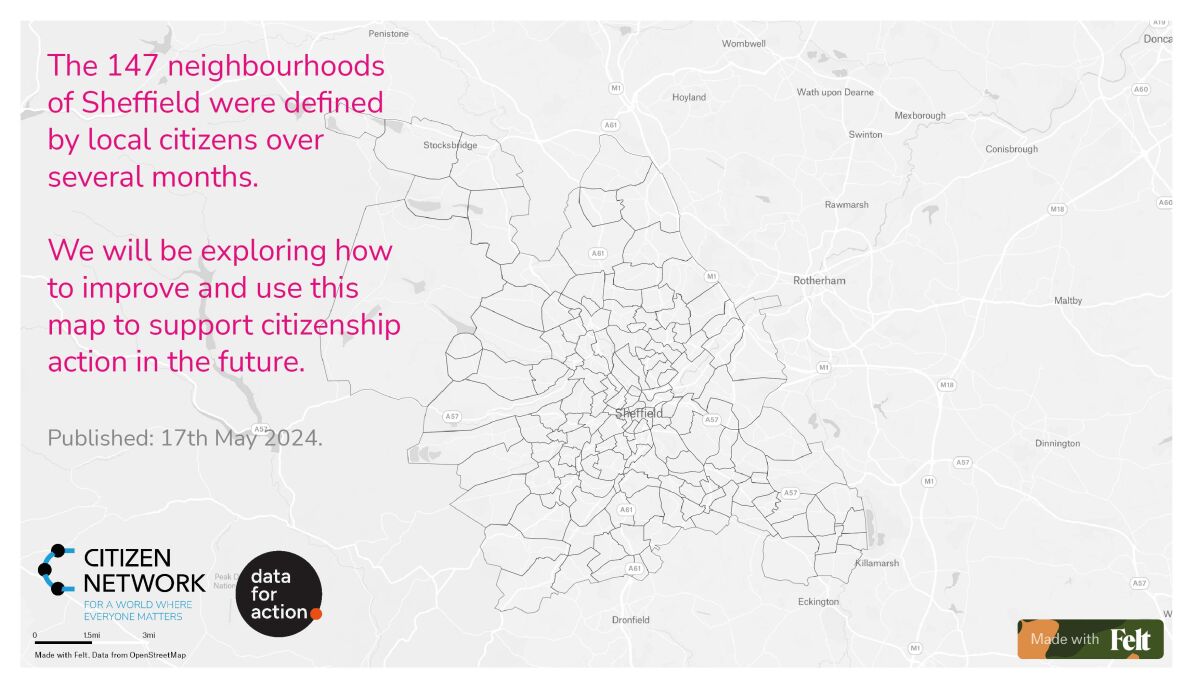Identifying our neighbourhoods is important because it helps citizens to share the work of taking care.
Authors: Simon Duffy and Tom French
Over the past few months Citizen Network and Data for Action have been working together with citizens from across Sheffield to map the neighbourhoods of Sheffield.
We think neighbourhoods are important. They are geographical communities at a human scale and there is good reason to think that neighbourhoods play an important role in creating a better world for everyone. If we want people to act like citizens, to care about each other, to take care of nature, to include people, to share resources and to make decisions together, then we need to feel a sense of responsibility to a community where our actions have immediate consequences and where we can form real relationships with our neighbours.
The other interesting thing is that most of us know we live in a neighbourhood that we can name. There may be some variations and some differences of opinion about the boundaries of those neighbourhoods—but neighbourhoods are not so mysterious. If you ask someone what neighbourhood they live in they will probably be able to tell you. But the only odd thing about Sheffield is that there has been no proper map of these neighbourhoods. This makes it rather difficult to do important things. It’s hard to organise things in neighbourhoods, to network neighbourhoods, to learn from or to share things between neighbourhoods when everything is so vague.
So, with a little financial support from NHS Sheffield, we offered citizens the chance to map the neighbourhoods of Sheffield. We used a technology called Maptionnaire to let people draw neighbourhoods and we met people in real neighbourhoods and asked them to define their part of Sheffield. This includes other ways of thinking about communities too, as well as the geographical neighbourhoods.
This has been quite a journey to date. You can find a snapshot of everything that’s happened and been produced so far here.
What we have ended up with is a map of 147 neighbourhoods and this is probably about the right number of neighbourhoods for a city as large as Sheffield. You can see this as a list here. We are not saying this is the final answer, we may have made mistakes and we can correct and improve this map over time. Also, at some point others in the city may decide to create an official neighbourhood map, and that might supersede ours. But we hope that this map is a useful starting point and we certainly have some plans about what we can do next.

We see it as a foundation for how different people across the city can develop or describe a range of different things and learn from each other. We would love it if you were willing to help us take this work further or adopt some of the ideas. There are 3 ways we would like to explore this next:
Please share any suggestions for improving or amending the map. We will listen to your comments and we will also talk to people in the city over the coming months. You can comment directly onto the map here. And here’s a bit of guidance on how to do that if you need it.
Many of you have expressed interest in working with us in the future and we need citizens from every part of the city to help us not just define the boundaries, but more importantly to use these maps to help make good things happen in your neighbourhood. If this sounds like you, it would be great if you could add your details to this short form so that we can keep you posted on things as and when they emerge.
Now that we have a map of all neighbourhoods we can create fresh and more detailed maps for every neighbourhood that represent the things of particular importance in that neighbourhood. We would really like to find a person or group in every neighbourhood of the city to help develop a richer picture of the neighbourhood. Some of you may be doing this already, of course. With your help we can also use this information to help citizens take action and also to help others make decisions that better respect the realities of your neighbourhood. Please get in touch if you would like to figure out a way of doing this.
That’s it for the time being. And we’ll be taking some time to digest everything over the summer and begin work again in the Autumn. But here’s an idea of some of the things that people have been thinking and which we think can be helped by building on this work in the future.
Citizen Network started in Sheffield, but it is a global movement for creating a world where everyone, absolutely everyone, matters. For us neighbourhoods are an essential element for a world where everyone can benefit from a life of citizenship and mutual respect.
For this reason it is vitally important that we start thinking differently about data. In many ways the current world runs on data and data is used by private corporations to sell things to us and to make money from us. So one of the things we know is that we also need to think about how we host and share data for the common good. We really welcome cooperation with others who share this goal.
The publisher is Citizen Network Research. Defining Our Neighbourhoods © Simon Duffy and Tom French 2024.
community, Constitutional Reform, local government, Neighbourhood Democracy, England, Article